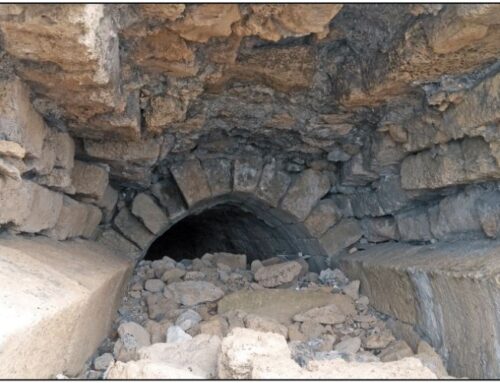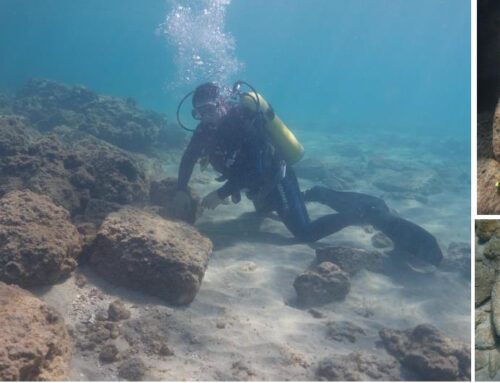The late Byzantine/early Islamic period Ma‘agan Mikhael shipwreck and its contribution to the study of the transition in ship construction – 2018
Dr Deborah Cvikel
The Ma‘agan Mikhael B shipwreck
The Ma‘agan Mikhael B shipwreck, dated to the 7th–8th century AD, is located about 70 m off the Israeli coast, at a maximum depth of 2.2 m, buried under 1.5 m of sand. The shipwreck is 19.6 m long between extremities, and maximum 4.9 m wide. Three underwater excavation seasons have been conducted in May and December 2016 and September 2017 by the Leon Recanati Institute for Maritime Studies of the University of Haifa. The location of the site is challenging, due to a small island which creates a meeting point between the offshore (south-west) current and a local (north-west) current and a disturbed sea. Hence, out of 44 potential excavation days, work was possible on only 21 days.
The hull
Among the hull remains, which are in a good state of preservation, are the two endposts, two aprons, framing timbers, hull planks, ceiling planks and bulkheads: the keel and keelson (if there is one) have not yet been exposed. Metal and wooden fastenings were used in the construction of the ship. The appearance of concretions, and the fact that very scanty remains of metal were found, indicate the use of iron nails.
Fifty-six framing timbers were exposed on the southern side of the hull, and sixty-three on the northern side. They were mostly made of Juglans regia and had various cross-sections. Some were made of partially worked half-logs – some bearing remains of bark; others were trapezoidal or rectangular. The face that was connected to an adjacent frame was worked and tool marks, possibly of a plane, were visible on some timbers.
Sixteen hull planks were exposed, six of which were documented and studied. They were made of Abies sp. and apparently connected to the frames by iron nails. Several of the planks near the two endposts had scorch marks on their inner surface, which might indicate bending through a heating process, known as ‘char-bending’. Edge-joints between planks have not been detected. Joints between plank ends have also not been found, so it is not yet known how strakes were made up.
There were two transverse sets of vertical planks, most probably bulkheads. The eastern and western bulkheads were located 13.8 m and 5.5 m from the western apron, respectively. The planks that comprised the bulkheads were exposed to a maximum length of 54 cm, but were longer. The bulkheads divided the hull into three compartments, creating spaces for stowing cargo or equipment.

Fig. 1. PhD candidate Michelle Creisher collecting pottery shards from the Ma‘agan Mikhael B shipwreck (Photo: A. Yurman)
The cargo
The Ma‘agan Mikhael B shipwreck bore a cargo of amphorae dating to the mid 6th–early 8th centuries AD. During the three seasons of excavation, 77 bags of sherds have been collected and recorded from within the shipwreck. In addition to the sherds, 37 complete amphorae have also been uncovered and documented. Amphorae of the Late Roman Types 1, 2, 4 and 5 have so far been identified among the cargo, along with two additional transport jars which have not yet been identified typologically. The majority of the amphorae seem to be LR 1 and LR 5. In addition to the amphorae, three bowls of the Cypriot Red Slip style and a cooking pot lid were also discovered and removed for documentation.
While the majority of the ceramics were located within the central section of the ship, both amphorae and sherds were also found in the fore and aft ends of the hull, separated by the bulkheads. The central section of the ship revealed a large number of amphorae, the majority of which appear to be LR 1, although other types of storage jars were also recorded along the sides of the hull. There does not appear to be any definitive separation of different types of transport jars within the ship, although the loading pattern of the cargo has not yet been made clear. Evidence for a second layer of jars below those exposed during excavation is suggested by the presence of additional rims, handles and bodies partially uncovered during the removal of other amphorae and other artefacts (Fig. 1). Most of the amphorae remain either upright or lying on their side, suggesting that they contained material when the ship sank.
Seven of the complete amphorae, along with the ceramic sherds, were retrieved and brought to the Leon Recanati Institute for Maritime Studies at the University of Haifa for further study. There, they underwent a desalination process in the conservation laboratory. Prior to desalination, each of the amphorae was carefully emptied of its contents, which were sieved, first through a 1.5 mm screen, and then through a 1 mm screen. Several of the jars were lined with pitch and held remains of foodstuff, which suggests that they were in secondary use. Five of the retrieved jars bore some kind of marking, either painted or incised letters in Greek and Arabic script; and some sherds have revealed additional fragments of inscriptions and dipinti.
Summary and future plans
The preliminary results proved the initial assumption that the Maʻagan Mikhael B shipwreck was an outstanding find. Based on the archaeological remains, it is suggested that the ship was a 20m-long merchantman plying the Levant coast. The study of the ship’s design, construction methods and finds is ongoing and will continue during future excavation seasons. It is contributing meaningful information on the ship, adding to the existing corpus of shipwrecks in Late Antiquity, and to the study of the transition in ship construction.
The quantity and variety of the ceramics found inside the shipwreck present a challenge to the scholarly theory of reduced maritime trade during the 7th and 8th centuries AD in the eastern Mediterranean, indicating a more diverse network of maritime trade than has previously been seen from this period in the region. The assemblage could aid in our understanding of the continuity of trade and the nature of maritime networks during the period of transition from the Byzantine to the Early Islamic period in this part of the eastern Mediterranean.
We are grateful to the Honor Frost Foundation for support in this research project.
Deborah Cvikel
Leon Recanati Institute for Maritime Studies and Department of Maritime Civilizations,
University of Haifa,
Haifa 3498838,
Israel





